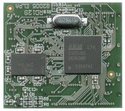Tiny ARM9 CPU module comes with Linux
Jul 5, 2007 — by LinuxDevices Staff — from the LinuxDevices Archive — 8 views A small company near Torino, Italy is shipping a tiny ARM9-based processor module designed for use with low-cost carrier boards. Elpa's RD129 comes pre-installed with the latest Linux kernel (currently 2.6.21.5), and is available with a handy development board.
A small company near Torino, Italy is shipping a tiny ARM9-based processor module designed for use with low-cost carrier boards. Elpa's RD129 comes pre-installed with the latest Linux kernel (currently 2.6.21.5), and is available with a handy development board.
(Click for larger view of the RD129 CPU module)
The RD129 is designed to work in conjunction with a user-designed carrier board, or with Elpa's RD126 development board (described below). The board-to-board interface comprises a pair of 60-pin (0.8mm pin pitch) surface-mounted connectors, “so a cheap two-sided PCB [printed circuit board] is enough,” the company said.
CPU module
The RD129 is powered by an ARM9-based Samsung SoC (system-on-chip) clocked at 266MHz. The module can be ordered with 16-64MB of 133MHz SDRAM, and 32MB or 64MB of flash. Clocked at full speed, the module requires only 1W, with 0.5W typical usage, Elpa said.

The RD129, top and bottom
Touted features, specs, and I/O includes:
- 3 x serial interfaces, one IrDA compatible
- 2 x USB host interfaces (one of which “can be used like USB device”)
- Synchronous serial interface to connect with 16-bits audio codec
- Video output for STN or TFT LCD screen
- Touch-screen interface
- 10-bits ADC converter
- IIC bus interface
- 2x SPI interfaces
- 4x internal PWM timers
- Up to 90 I/O pins
- Single 3.3Vdc supply
Development board
The RD126 development board lets users develop software before their custom baseboards are finished. In addition to typical real-world I/O, the board appears to expose 110 of the RD129 CPU module's 120 pins, on pin headers with a 0.1-inch pin pitch.
The RD126 with RD129 in place. Note how the CPU module's pins are brought out to two 0.1-inch-pitch pin headers
Touted RD126 board features include:
- Requires single 5VDC power
- 3.3V switching power supply
- Level translator for 2x RS232 serial interfaces
- USB-to-Ethernet converter, and its connector
- USB Host connector
- MMC or SD flash memory card connector
- 16 bits in/out stereo audio codec
- IICbus EEPROM
- Real-time clock with lithium backup battery
- FPC connectors for optional LCDs
- JTAG debug connector
- One RD129 CPU board

RD126 with optional stacked LCD module
Additionally, the RD126 board is optionally available with a choice of three display modules, which appear to stack on top of the board and connect via flex-PC (flexible printed circuit). Available display options include:
- TFT 3.5-inch 240×320 LED backlighted
- STN 5.7-inch 320×240 CCFL backlighted and its inverter
- TFT 5.7-inch 320×240 CCFL backlighted and its inverter
Availability
The RD129 CPU module is available now, priced at 70 Euros (approx. $95) in quantities of 100, with 32MB of SDRAM and 64MB of flash, according to the company.
This article was originally published on LinuxDevices.com and has been donated to the open source community by QuinStreet Inc. Please visit LinuxToday.com for up-to-date news and articles about Linux and open source.
